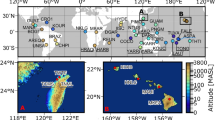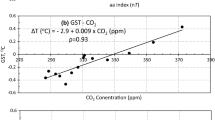Abstract
With a view to difficulties with explaining the physical mechanism of solar forcing on the Earth’s climate, we applied a new approach of determining and quantifying an influence of solar-related events on water vapor variability by correlating the total electron content (TEC) and precipitable water vapor (PWV), both derived from ground-based GPS observations.
In this study, ionospheric TEC and atmospheric PWV values are employed as solar activity and terrestrial climate parameters, respectively. Three-year GPS data at five stations in Antarctica are analyzed on a daily mean basis. Results show significant correlation between TEC and PWV differences during storms-affected days. The high correlation between the daily mean values of TEC and PWV, both of which follow the seasonal signals and subsisting downward trend, suggests an influence of solar activity on climate variability in Antarctica. These quantities are determined by changes of the upper-atmosphere level, which varies in conformity with the zenith angle of the Sun.
Similar content being viewed by others
References
Abdul Rashid, Z.A., M.A. Momani, S. Sulaiman, M.A. Mohd Ali, B. Yatim, G. Fraser, and N. Sato (2006), GPS ionospheric TEC measurement during the 23rd November 2003 total solar eclipse at Scott Base Antarctica, J. Atmos. Sol.-Terr. Phys. 68,11, 1219–1236, DOI: 10.1016/j.jastp.2006.03.006.
Alber, C., R. Ware, C. Rocken, and F. Solheim (1997), GPS surveying with 1 mm precision using corrections for atmospheric slant path delay, Geophys. Res. Lett. 24,15, 1859–1862, DOI: 10.1029/97GL01877.
Ataç, T., and Özgüç A. (1996), North-south asymmetry in the solar flare index, Solar Physics 166,1, 201–208.
Baker, D.N., N.E. Turner, and T.I. Pulkkinen (2001), Energy transport and dissipation in the magnetosphere during geomagnetic storms, J. Atmos. Sol.-Terr. Phys. 63,5, 421–429, DOI: 10.1016/S1364-6826(00)00169-3.
Bevis, M., S. Businger, T.A. Herring, C. Rocken, R.A. Anthes, and R.H. Ware (1992), GPS meteorology: Remote sensing of atmospheric water vapor using the Global Positioning System, J. Geophys. Res. 97,D14, 15,787–15,801.
Businger, S., S.R. Chiswell, M. Bevis, J. Duan, R.A. Anthes, C. Rocken, R.H. Ware, M. Exner, T. van Hove, and F.S. Solheim (1996), The promise of GPS in atmospheric monitoring, Bull. Am. Meteor. Soc. 77, 5–18.
Duan, J., M. Bevis, P. Fang, Y. Bock, S. Chiswell, S. Businger, C. Rocken, F. Solheim, T. van Hove, R. Ware, S. McClusky, T.A. Herring, and R.W. King (1996), GPS meteorology: Direct estimation of the absolute value of precipitable water, J. Appl. Meteorol. 35,6, 830–838.
Friis-Christensen, E., and K. Lassen (1991), Length of the solar cycle: an indicator of solar activity closely associated with climate, Science 254, 698–700, DOI: 10.1126/science.254.5032.698.
Fröhlich, C., and J. Lean (1998), The sun’s total irradiance: Cycles, trends, and related climate change uncertainties since 1976, Geophys. Res. Lett. 25,23, 4377–4380.
Gleisner, H., and P. Thejll (2003), Patterns of tropospheric response to solar variability, Geophys. Res. Lett. 30,13, 1711, DOI: 10.1029/2003GL017129.
Gonzalez, W.D., J.A. Joselyn, Y. Kamide, H.W. Kroehl, G. Rostoker, B.T. Tsurutani, and V.M. Vasyliunas (1994), What is a geomagnetic storm? J. Geophys. Res. 99, 5771–5792.
Hathaway, D.H., and R.M. Wilson (2004), What the sunspot record tells us about space climate, Solar Phys. 224, 5–19.
Klobuchar, J.A., and J.M. Kunches (2003), Comparative range delay and variability of the earth’s troposphere and the ionosphere, GPS Solutions 7,1, 55–58, DOI: 10.1007/s10291-003-0047-5.
Labitzke, K., and H. van Loon (1992), Association between the 11-year solar cycle and the atmosphere. Part V: Summer, J. Climate 5, 240–251.
Marsh, N.D., and H. Svensmark (2000), Low cloud properties influenced by cosmic rays, Phys. Rev. Lett. 85, 5004–5007, DOI: 10.1103/PhysRevLett.85.5004.
Rishbeth, H. (1997), Long-term changes in the ionosphere, Adv. Space Res. 20,11, 2149–2155, DOI: 10.1016/S0273-1177(97)00607-8.
Rocken, C., R. Ware, T. Van Hove, F. Solheim, C. Alber, J. Johnson, M. Bevis, and S. Businger (1993), Sensing atmospheric water vapor with the global positioning system, Geophys. Res. Lett. 20,23, 2631–2634, DOI: 10.1029/93GL02935.
Shindell, D., D. Rind, N. Balachandran, J. Lean, and P. Lonergan (1999), Solar cycle variability, ozone, and climate, Science 284,5412, 305–308, DOI:10.1126/science.284.5412.305.
Suparta, W., Z.A. Abdul Rashid, M.A. Mohd Ali, B. Yatim, and G.J. Fraser (2008), Observations of Antarctic precipitable water vapor and its response to the solar activity based on GPS sensing, J. Atmos. Sol.-Terr. Phys. 70, 1419–1447. DOI: 10.1016/j.jastp.2008.04.006.
Suparta, W., M.A. Mohd Ali, B. Yatim, and J.G. Fraser (2009), Analysis of GPSsensed atmospheric water vapor variability and its response to the terrestrial winds over Antarctica, Physics and Chemistry of the Earth 34,1–2, 72–87, DOI: 10.1016/j.pce.2008.07.010.
Tobiska, W.K. (2001), Validating the solar EUV proxy, E10.7, J. Geophys. Res. 106,A12, 29,969–29,978.
Tsurutani, B.T., A.J. Mannucci, B. Iijima, F.L. Guarnieri, W.D. Gonzalez, D.L. Judge, P. Gangopadhyay, and J. Pap (2006), The extreme Halloween 2003 solar flares (and Bastille Day, 2000 Flare), ICMEs, and resultant extreme ionospheric effect: A review, Adv. Space Res. 37,8, 1583–1588, DOI:10.1016/j.asr.2005.05.114.
Van Lipzig, N.P.M., E. van Meijgaard, and J. Oerlemans (2002), Temperature sensitivity of the Antarctic Surface Mass Balance in a regional atmospheric climate model, J. Climate 15,19, 2758–2774, DOI: 10.1175/1520-0442 (2002)015〈2758:TSOTAS〉2.0.CO;2.
Vey, S., R. Dietrich, K.-P. Jonhsen, J. Miao, and G. Heygster (2004), Comparison of tropospheric water vapor over Antarctica derived from AMSU-B data, Ground-Based GPS data and the NCEP/NCAR reanalysis, J. Meteorol. Soc. Jpn. 82,1B, 259–267, DOI: 10.2151/jmsj.2004.259.
Author information
Authors and Affiliations
Corresponding author
Rights and permissions
About this article
Cite this article
Suparta, W., Yatim, B. & Mohd Ali, M.A. Solar forcing on antarctic terrestrial climate: A study by means of GPS observations. Acta Geophys. 58, 374–391 (2010). https://doi.org/10.2478/s11600-009-0035-4
Received:
Accepted:
Published:
Issue Date:
DOI: https://doi.org/10.2478/s11600-009-0035-4




